Another port, another tour. Holy cow – what were we thinking? Well, this one isn’t really a tour-tour. It’s called Hoi An on your own, so it’s transportation there and back. It’s another 2 or so hours away, so we want to be safe rather than sorry on a private transfer. So, once again, we report to the theater, grab our stickers and head out to find our bus. We’ve got a map from Guest relations (they are really good with the maps and info – nice to have) and a basic game plan to just wander around the town. It’s a small tourist center, and we figure we’ll have plenty to do in the 3 hours we have free to wander.
Our tour guide, Bao, has the cutest accent. It takes a bit to figure out some of his words, but he’s so sweet and full of info, you just go with it (“soldier” was particularly perplexing until I figured it out).
The drive is a long one again, about 2 hours – but we get a mini sightseeing tour as we have to drive through Danang. Bao gives us a running overview of what we are seeing – China Beach,
and the areas where the American’s had bases, still old helicopter hangars standing, but the airport has been moved, etc. – it’s interesting to see, but we’re glad we are going to Hoi An and not just touring here.
As we leave the city, the scenery becomes the normal Vietnamese countryside – rice farms, complete with workers in the fields. The harvest is much closer here in the South than around Hanoi to the North.
The ride goes fairly quickly and we get to Hoi An, where Bao gives us additional maps, a little business card with his name and number on it in case we get lost and tickets to get into the city, plus 5 attractions in town. This is a bonus, I figured we’d have to buy the admission tickets, but not so. Hey, cool. He also tells us he will walk us to the Japanee (Japanese – I just loved the way he says it!) Covered Bridge and show us our meeting point for coming back to the bus. First, though, we go to a souvenier market where we have 15 minutes to shop or go to the bathroom. I choose the bathroom, of course, and it takes the entire 15 minutes to stand in line with the hundreds of other tourists brought here for the same reason. Ugh. But one must do what one must do. At least these bathrooms are western and have toilet paper! Shocking but happily true.
We regroup, and make our way through a crowded market selling all sorts of Vietnamese goods – souvenirs, scarves, bags, you name it, and finally emerge at the Japanee Covered Bridge. Bao then gives us a little overview and history of the bridge. It was built in the shape of a sword to fight off a sea monster that threatened the city.
As we stand and listen to him, one of the European guests rudely interrupts him and asks “Excuse me, can you tell me the name of this tour?” Oh, please, don’t be a jerk. But yes, he is a jerk. He then berates our little (and I mean little, as in diminutive) Bao that this is the Hoi An “ON YOUR OWN” and he just wants to know where and what time we will meet to go back to the ship. Thanks bud – we were quite happy with our little tour here – so bugger off.
Bao takes us across the bridge, with some quick explanations and shows us where to meet. He also gives us 4 hours – yay! We can have lunch. That was what we were hoping (even though the tickets said 3 hours in Hoi An).
We’ve read that Hoi An is one of the “best towns on earth” and a haven for foodies. That may be so, if you can explore the larger area of Hoi An, but with our limited time, we stick to the old part of the city which is ancient, but incredibly touristy.
The town is an old merchant town, situated perfectly on the river for merchant trade. For over 1,000 years, traders from all over the world – Europe, China, Japan – descended on the little town trading silk, gems, tea and precious metals. That is why the architeture is so unique and varied. Everything from Japanese peaked roofs, to French colonial to Chinese pagodas can be found in the old city. The trade dried up when the river silted up in the 19th century, and since then the town has been preserved and is now a UNESCO World Heritage listed sight.
Most of the ancestry here is Chinese. And the predominate architectural influence. The sights available to us are mostly community assembly halls, but also some merchant homes. Our first stop is the Fujian Congregation temple, which is purportedly the best one to visit. It is gorgeous with sculptured gardens and unique triple arched gateways.
Inside is beautiful as well, with altars and buddhas all around. A small replica fishing boat (or some sort of boat, we were told fishing boats don’t paint eyes on the front because the eyes will scare the fish). Plus a large interior courtyard, currently filled with offerings to Fujian families within the community for the New Year.
We meander through the little lanes of the town, avoiding the pedicabs and scooters bearing down on us. We find the market, and dive into parts of it, looking at all the fresh seafood, different produce and yes, the egg guy! How many chickens must he have to get that basket of eggs!
It’s sort of crazy busy around here, so we head back to the main drag to find some place to sit and have a beer. We see a couple of signs for Bia Hoi, but it is too early in the morning for them to be open yet. Bummer. So we settle for a regular bottled beer as we relax and watch the throngs of people walk by. After quenching our thirst, we head over to the Quan Thang house, which is one of the oldest houses in Hoi An. It is a typical example of the houses that used to connect the 2 main roads of Hoi An together, from front and back. It is currently occupied, we are assuming wtih descendents from the Quan Thang clan – but who knows? What we do know is they take our tickets and then we walk inside their house – which is sort of odd and unsettling as we feel like we are intruding.
The house is divided into different sections, but there is nothing to indicate for what each room is used. There are 2 front rooms, which open up onto a lovely little garden area with a cool sculpture on the wall.
The family is all about the house, doing their normal things – one girl is making what she tells me are white roses in the kitchen. Not very friendly or talkative, but then, I guess you don’t go out of your way when you’ve got thousands of people trooping through your house every day!
Then out back, just outside the kitchen is an open area with roosters in a cage (you probably can’t see them there on the ground on the left). Again, amazing the living conditions.
Enough wandering, we’re hungry so we go in search of lunch. We toyed with the idea of walking out of the historic district to a restaurant we had read had “the best banh mi in all of Vietnam.” But, we can get Banh Mi anywhere, and there is a local Hoi An specialty called Cao Lau that we want to try (it is said to be made with noodles that are a secret recipe known only by a few people in the area - or so the story goes). We luck into this little place on the main drag called Dac San where they have a 4 part menu priced reasonably enough, and it includes Cao Lau. A ship couple is eating there already and they say it is good, so we plop down at a table, order beers and make our decisions: I get #1 which has Fried shimp with sugarcane, White rose (yay – we get to try what that girl was making), which is rice paper with shrimp inside, a fried wonton and Cao lau with pork. Ed gets #5 which has White rose, a rice pancake, vegetable spring roll and Cao Lau.
Everything is great. And tons of food. And cheap! Even at their bad exchange rate, it is only $5 each (should be $4, but let’s not go there). Great lunch and great place to rest and relax and watch the world go by. After we finish, we still have time, so we meander some more, and head down to the river to take some pictures of the more picturesque buildings.
Then back to our meeting point for more pictures of the bridge, an unidentified statue, the old town streets and what we think are fresh cut french fries being dried in the sun on the back of a scooter? Hmmm…
The group is all ontime, and so is Bao. He meets us in the shade by the river and escorts us quickly to the bus for our drive home. The hour and a half slips by. This time our rest stop is a marble factory, because it is located by the marble mountain – a mountain where you can see strains of marble running through the rock. We’d seen bunches of these places on the way up, so it’s great we are getting to stop here now. Bao tells us we can visit this place, or just “maintain on the bus.” I love his sayings! We choose to visit and wander around marveling at all the great marble pieces.
We even succomb to our own little piece of Vietnam – a marble buddha. For the fireplace. We’re happy!
Back on the bus, it is freezing. I have a long sleeve shirt and I’m still cold. We try to adjust the vents, and one actually breaks and gets shoved back up into the vent. Oh no! So, now the air is really pouring out like crazy. After a couple minutes strategy, we finally stick a water bottle up there to –quite literally – bottle up the air!
We actually get a round of applause for that quick thinking! The guys behind us were obviously freezing too. LOL.
The bus safely deposits us on the dock and we head back aboard, ontime and ready to sail. It was a nice day, but as we both remarked, it was sort of like Vietnam for Beginners. Entry level perhaps, but still fun, nice, definitely a place to see, and we had the perfect amount of time there – but after spending time in other Vietnamese cities, we wouldn’t want much more here.

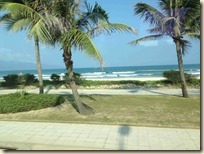
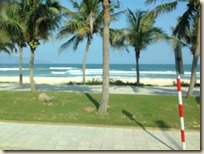

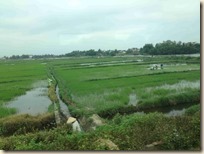
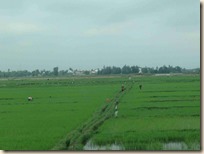


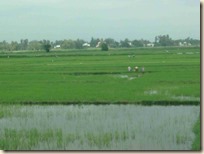

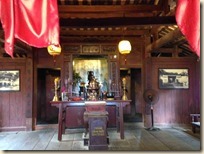
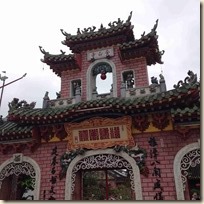
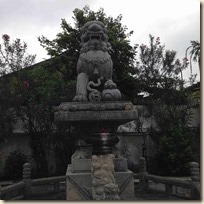

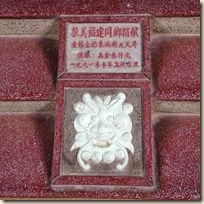
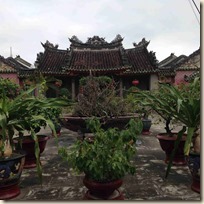





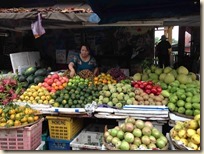


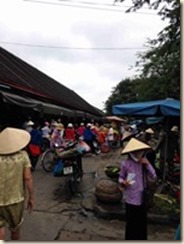
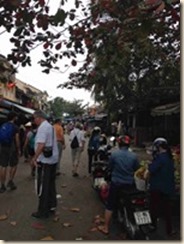




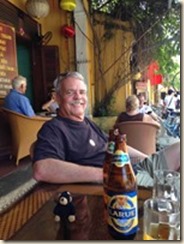



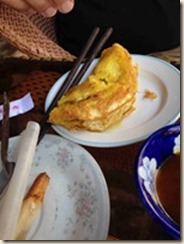




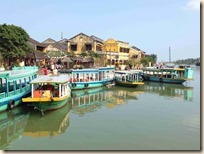
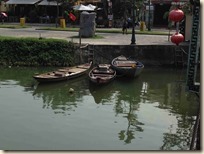
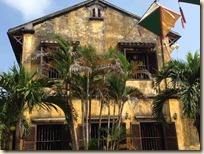
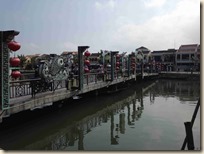
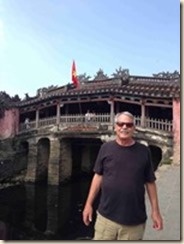
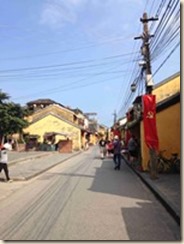


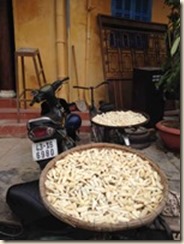


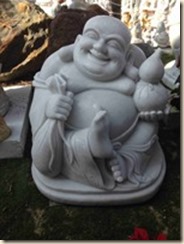



No comments:
Post a Comment